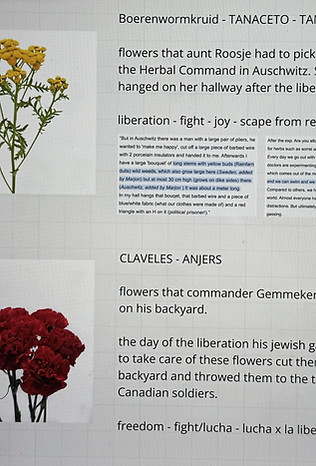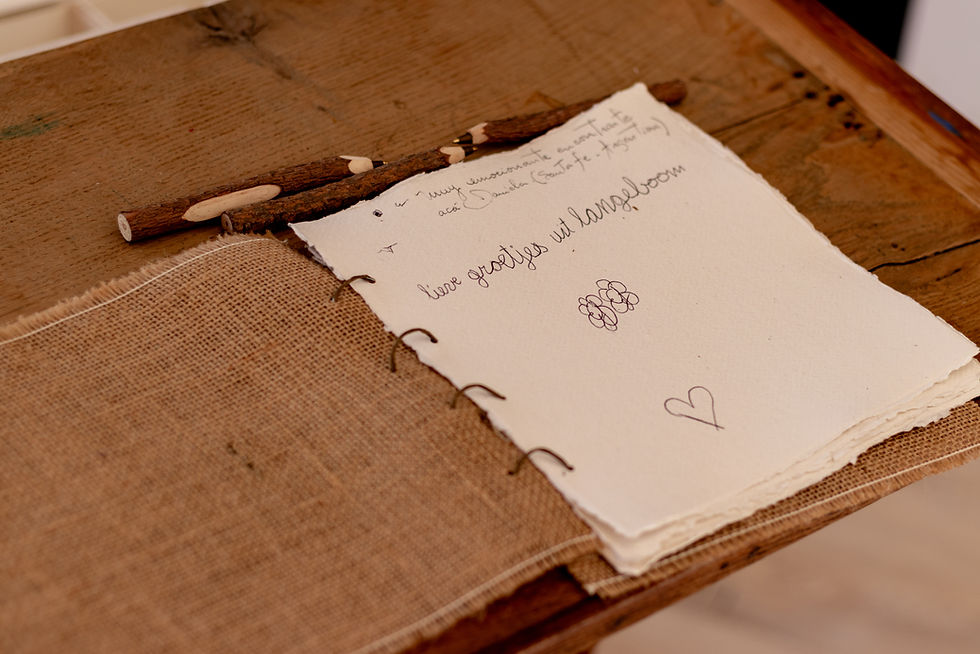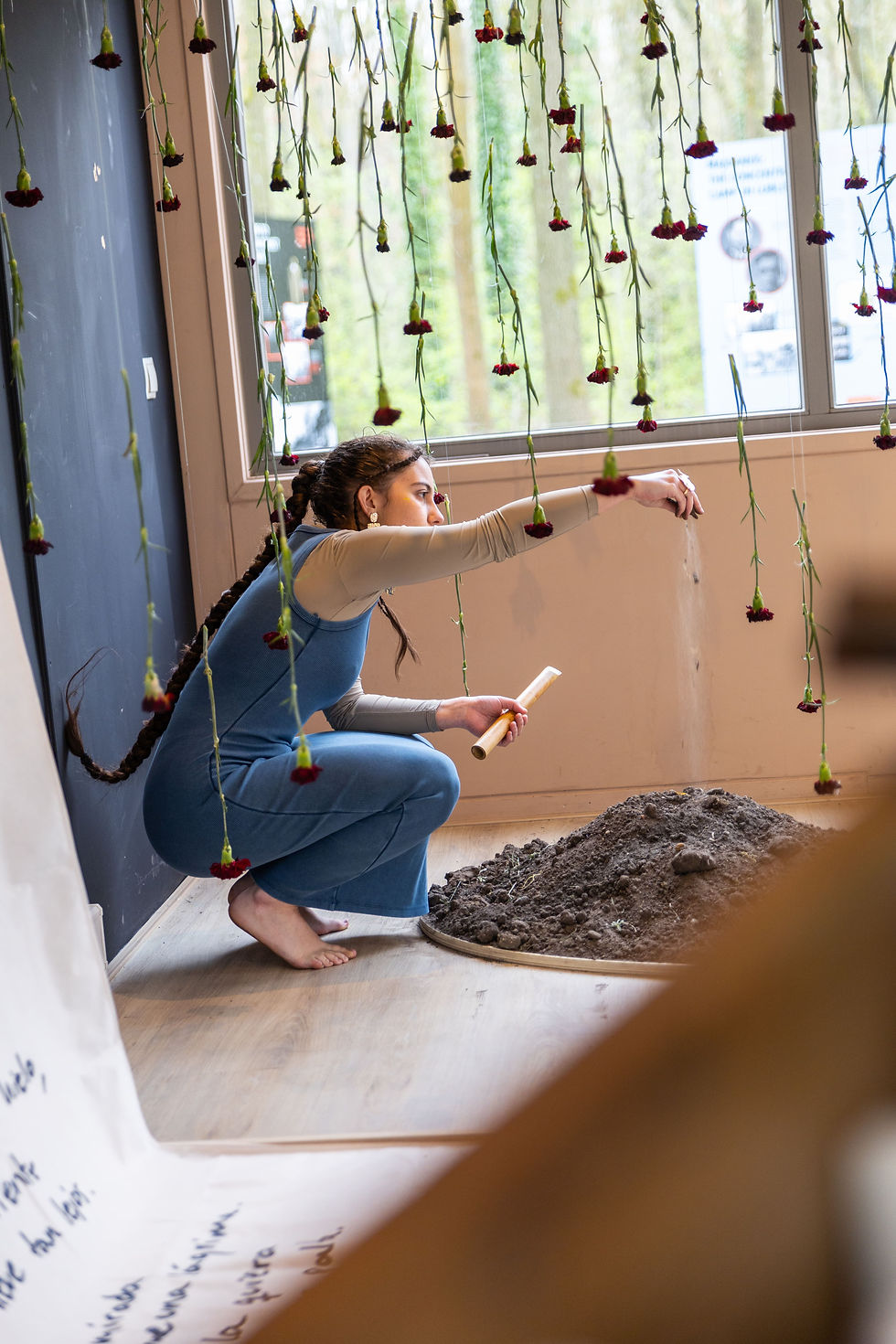CELIA SERRANO
artivist · composer · saxophonist · singer · facilitator
DNA of the land
A multidisciplinary immersive installation created during an artistic residency at Kamp Westerbork (2024-2025)

Nature is a witness of memory, history, and the past. We believe we can mold the land in our own image and likeness.
Yet the earth, wise and ancient, neither forgets nor forgives. It resists. It remembers. It tells stories.



For several months, I immersed myself in the complex and moving history of Kamp Westerbork. I researched its past through books, guided tours of the site, and two weeks of fieldwork directly on location — listening, observing, and absorbing everything I could to gain insight and inspiration for the creation of this piece.
I was given complete artistic freedom, with only two guiding parameters: 1) the work had to commemorate the 80th anniversary of the camp’s liberation in 2025; 2) it would be exhibited in a space for a full month, which meant it couldn’t be just a musical composition, the piece needed to include some element(s) that could remain present in the space, resonating with visitors over time.

DNA of the Land was conceived as a multisensory art installation, featuring visual elements throughout the space and a sound composition designed to create an immersive experience for the audience.




DNA of the land is an artistic exploration of the soil as a living archive, a silent yet powerful narrator of time. Beneath our feet, the earth holds the imprints of history — traces of those who walked before us, roots that withstood oblivion, seeds that carried whispers, echoes that bloomed the past. Through its layers, we uncover lost voices, the scars of human intervention, and nature pushing through, reclaiming its voice.
This piece invites us to look through the lens of the soil and listen to the stories buried within. The earth is more than a resource—it is memory, witness, and legacy. It is the mother who nurtures and the woman who resists. It carries the weight of time, the fertility of life, and the force of transformation. By engaging with the land, we reconnect with the past, learn in the present, and reimagine the future.

At the heart of this piece is Ojalá, a poem I wrote and later turned into a song. It was inspired by the testimony of a Westerbork survivor — a mother and daughter, Bertha and Joela Heijmans, who lived in the camp, where the daughter spent her entire childhood. This story deeply moved me, there was a sentence in particular that stayed etched in my mind:
“When my mother cried, I licked the tears to get the salt in.”
That haunting image became a powerful symbol, and it made me reflect on what life must have been like for this mother and daughter in the camp.
The poem unfolds as if the daughter were speaking to her mother — between dream, delirium, and fantasy. At once a cry, a lullaby, and a waking dream, she tells her mother:
“I wish your tears weren’t needed to feed me. I wish it were your kisses that nourished me instead.”

One of the central elements in my piece is soil. For me, bringing a piece of earth from the camp into the exhibition space was already a powerful symbol in itself — as if carrying the traces of history into the room.
Soil holds the memory of everything that has happened.
In my symbolic universe and conceptual process, soil represents the woman — Mother Earth, fertility, and resilience. And in this context, it also embodies Joela Heijmans, the mother from the testimony.

Another element I chose to include in the piece was carnations. But why carnations?
During my research, I came across a historical account that struck me deeply. The camp’s commander, Gemmeker, had a particular fondness for carnations. He assigned a Jewish gardener to plant and tend them in his private garden.
On the day of the camp’s liberation — April 12th, 1945 — as the Canadian troops arrived, the gardener went to that garden, cut the carnations, and threw them onto the tanks as a gesture of gratitude and a symbol of freedom. That image stayed with me. It was this story that led me to include carnations in the piece.
The number of carnations was not arbitrary: I used 107, representing the 107,000 people who passed through Westerbork.
I also decided to place the flowers upside down as a symbol of revolution — a quiet act of defiance. The same flowers the gardener was once forced to cultivate now look the other way.

Another element in DNA of the Land was tansy. This choice came after meeting Marjon and learning the story of her aunt, Roosje Glaser. After the war, Roosje moved to Stockholm, where she kept a bouquet of tansy in the corner of her hallway, which for her symbolized liberation.
But why tansy?
In Auschwitz, Roosje had been assigned to the Herbal Kommando, where she was made to gather tansy. Those moments became small escapes, windows through which she could imagine life beyond the camp.
This image stayed with me. Tansy came to symbolize this liberation, hope, and escape. That is why I chose to include it in the piece, as a dried bouquet, representing the imprint of memory, and that which endures over time.

A chair was placed directly in front of the piece of soil. A silent image of memory, a quiet invitation to sit.
Its position was no coincidence. Facing the soil and the flowers, the chair became a space for stillness and reflection. A way of looking at the land — and feeling how the land looks back at us: silent, unyielding, alive.
In my conceptual universe, made of layers and layers of meaning, the chair represents Bertha Heijmans, the daughter, gazing at her mother Joela Heijmans (the soil), enveloped by the soundscape of Ojalá, where Bertha is embodied, pleading softly to her mother to not cry.
Whoever sits in the chair becomes Bertha. And yet, not only Bertha, but any human being, sitting before their mother, before Mother Earth, speaking to her, listening to her, looking at her. In silence.
The space between the chair and the soil is the dream.

Another element of the installation was a table, placed at the end of the visitor’s journey. On it rested a book — an Artist’s Book I created to open a window into my creative process, weaving together the thoughts, connections, and associations that gave life to this piece.
I crafted it entirely by hand, page by page, and bound it myself.

I also placed another handmade book here, this one empty and open, inviting visitors to fill its pages with their thoughts and dedications.
By the end of the exhibition, it had blossomed with heartfelt messages. One phrase echoed repeatedly: “Please, no more wars.”

Lastly, the table held small cards, gifts for visitors to take with them.
Each card carried the name of one of the three flowers that have been symbols of this piece: carnations, tansies, and lupines; a phrase from a song I composed, also inspired in Westerbork; seeds to plant those flowers; and a QR code linking to more about their meaning and how to care for them.
A way for DNA of the Land to take root beyond Westerbork.
You can discover where the QR code leads by clicking the button below.




Alongside the installation, I offered two live performances within the art piece itself, interpreting Ojalá —the composition I created specifically for the installation, which usually played through the speakers during the exhibition. These performances added a new layer to the work, deepening its meaning and offering the audience an even more immersive and complete experience.
They were not conceived as “typical concerts”; instead, I developed a character and narrative, incorporating theatrical elements and interacting with the space in an embodied way. This approach became a rich learning experience, and gave me the opportunity to create a solo performance, for a unique and emotionally charged context like Westerbork.
It was both challenging and deeply moving to witness how the audience responded to this format, so different from what I'm used to.

DNA of the Land was a piece woven with multiple layers of meaning, born from deep reflection and the childlike curiosity that lives within me. It was a project into which I poured my whole heart and passion, one that made me feel, throughout the entire process, the joy and wonder of a child at play.
I hope this glimpse brings you closer to understanding what this piece meant to me. And even if only virtually, I hope you can carry with you a small seed of its essence. Though the installation was temporary, its spirit endures, and by sharing it here, I hope it continues to grow and resonate within you.





